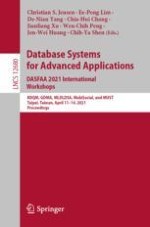This volume constitutes the papers of several workshops which were held in conjunction with the 26th International Conference on Database Systems for Advanced Applications, DASFAA 2021, held in Taipei, Taiwan, in April 2021.
The 29 revised full papers presented in this book were carefully reviewed and selected from 84 submissions.
DASFAA 2021 presents the following five workshops:
6th International Workshop on Big Data Quality Management (BDQM 2021)
5th International Workshop on Graph Data Management and Analysis (GDMA 2021)
First International Workshop on Machine Learning and Deep Learning for Data Security Applications (MLDLDSA 2021)
6th International Workshop on Mobile Data Management, Mining, and Computing on Social Network (MobiSocial 2021)
2021 International Workshop on Mobile Ubiquitous Systems and Technologies (MUST 2021)
Due to the Corona pandemic this event was held virtually.
